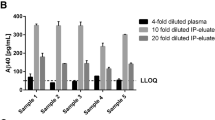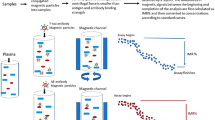Abstract
A rolling circle amplification chemiluminescence immunoassay (RCA-CLIA) was developed for precise quantitation of Aβ in plasma. Capture antibodies conjugated with magnetic beads and detection antibodies with collateral single-stranded DNA (ssDNA) were bound to Aβ42/Aβ40 antigens to form a typical double-antibody sandwich structure. The RCA reaction was triggered by the addition of ssDNA, which generated products with a large number of sites for the binding of acridinium ester (AE)–labeled detection probes, thereby realizing the purpose of the amplification. The RCA-CLIA method had higher sensitivity than conventional CLIA without loss of specificity. Under optimum conditions, the linear range of Aβ42 and Aβ40 detection was 3.9–140 pg/mL and 3.9–180 pg/mL, respectively, with corresponding low detection limits of 1.99 pg/mL and 3.14 pg/mL, respectively. Plasma Aβ42 and Aβ40 were detected in the blood of 21 AD patients and 22 healthy people, wherein this ratio could significantly distinguish AD patients from healthy individuals with a sensitivity of 90.48% and specificity of 63.64% for a cutoff value of 154. The Aβ42/Aβ40 ratio of plasma acts as an accurate indicator for AD diagnosis; therefore, detection of plasma Aβ using the RCA-CLIA exhibits great potential in noninvasive diagnosis and progressive assessment of AD.




Similar content being viewed by others
References
Holtzman DM, Morris JC, Goate AM (2011) Alzheimer’s disease: the challenge of the second century. Sci Transl Med 3(77):77sr71. https://doi.org/10.1126/scitranslmed.3002369
Tremblay C, Francois A, Delay C, Freland L, Vandal M, Bennett DA, Calon F (2017) Association of neuropathological markers in the parietal cortex with antemortem cognitive function in persons with mild cognitive impairment and Alzheimer disease. J Neuropathol Exp Neurol 76(2):70–88. https://doi.org/10.1093/jnen/nlw109
Tremblay C, Pilote M, Phivilay A, Emond V, Bennett DA, Calon F (2007) Biochemical characterization of Abeta and tau pathologies in mild cognitive impairment and Alzheimer’s disease. J Alzheimers Dis 12(4):377–390. https://doi.org/10.3233/jad-2007-12411
Bourassa P, Tremblay C, Schneider JA, Bennett DA, Calon F (2019) Beta-amyloid pathology in human brain microvessel extracts from the parietal cortex: relation with cerebral amyloid angiopathy and Alzheimer’s disease. Acta Neuropathol 137(5):801–823. https://doi.org/10.1007/s00401-019-01967-4
Dhiman K, Blennow K, Zetterberg H, Martins RN, Gupta VB (2019) Cerebrospinal fluid biomarkers for understanding multiple aspects of Alzheimer’s disease pathogenesis. Cell Mol Life Sci 76(10):1833–1863. https://doi.org/10.1007/s00018-019-03040-5
Nakamura A, Kaneko N, Villemagne VL, Kato T, Doecke J, Dore V, Fowler C, Li QX, Martins R, Rowe C, Tomita T, Matsuzaki K, Ishii K, Ishii K, Arahata Y, Iwamoto S, Ito K, Tanaka K, Masters CL, Yanagisawa K (2018) High performance plasma amyloid-beta biomarkers for Alzheimer’s disease. Nature 554(7691):249–254. https://doi.org/10.1038/nature25456
Schindler SE, Bollinger JG, Ovod V, Mawuenyega KG, Li Y, Gordon BA, Holtzman DM, Morris JC, Benzinger TLS, Xiong C, Fagan AM, Bateman RJ (2019) High-precision plasma beta-amyloid 42/40 predicts current and future brain amyloidosis. Neurology 93(17):e1647–e1659. https://doi.org/10.1212/WNL.0000000000008081
Janelidze S, Zetterberg H, Mattsson N, Palmqvist S, Vanderstichele H, Lindberg O, van Westen D, Stomrud E, Minthon L, Blennow K, Fsg SB, Hansson O (2016) CSF Abeta42/Abeta40 and Abeta42/Abeta38 ratios: better diagnostic markers of Alzheimer disease. Ann Clin Transl Neurol 3(3):154–165. https://doi.org/10.1002/acn3.274
Lewczuk P, Matzen A, Blennow K, Parnetti L, Molinuevo JL, Eusebi P, Kornhuber J, Morris JC, Fagan AM (2017) Cerebrospinal fluid Abeta42/40 corresponds better than Abeta42 to amyloid PET in Alzheimer’s disease. J Alzheimers Dis 55(2):813–822. https://doi.org/10.3233/JAD-160722
Parnetti L, Chiasserini D, Eusebi P, Giannandrea D, Bellomo G, De Carlo C, Padiglioni C, Mastrocola S, Lisetti V, Calabresi P (2012) Performance of abeta1-40, abeta1-42, total tau, and phosphorylated tau as predictors of dementia in a cohort of patients with mild cognitive impairment. J Alzheimers Dis 29(1):229–238. https://doi.org/10.3233/JAD-2011-111349
Andreasen N, Minthon L, Davidsson P, Vanmechelen E, Vanderstichele H, Winblad B, Blennow KJAon (2001) Evaluation of CSF-tau and CSF-Abeta42 as diagnostic markers for Alzheimer disease in clinical practice. Arch Neurol 58(3):373–379. https://doi.org/10.1001/archneur.58.3.373
Selkoe DJJoAsdJ (2001) Alzheimer's disease results from the cerebral accumulation and cytotoxicity of amyloid beta-protein. J Alzheimers Dis 3(1):75–80. https://doi.org/10.3233/jad-2001-3111
Hardy J, Selkoe DJS (2002) The amyloid hypothesis of Alzheimer's disease: progress and problems on the road to therapeutics. Science 297(5580):353–356. https://doi.org/10.1126/science.1072994
Kaneko N, Nakamura A, Washimi Y, Kato T, Sakurai T, Arahata Y, Bundo M, Takeda A, Niida S, Ito K, Toba K, Tanaka K, Yanagisawa K (2014) Novel plasma biomarker surrogating cerebral amyloid deposition. Proc Jpn Acad Ser B Phys Biol Sci 90(9):353–364. https://doi.org/10.2183/pjab.90.353
Ovod V, Ramsey KN, Mawuenyega KG, Bollinger JG, Hicks T, Schneider T, Sullivan M, Paumier K, Holtzman DM, Morris JC, Benzinger T, Fagan AM, Patterson BW, Bateman RJ (2017) Amyloid beta concentrations and stable isotope labeling kinetics of human plasma specific to central nervous system amyloidosis. Alzheimers Dement 13(8):841–849. https://doi.org/10.1016/j.jalz.2017.06.2266
Yaka E, Egrilmez MY, Keskinoglu P, Cavdar Z, Genc S, Genc K, Iyilikci L, Yener GG (2009) Biological markers in cerebrospinal fluid (CSF) and evaluation of in vitro effect of CSF on PC12 cell line viability in Alzheimer’s disease. Cell Biochem Funct 27(6):395–401. https://doi.org/10.1002/cbf.1588
Deming Y, Xia J, Cai Y, Lord J, Holmans P, Bertelsen S, Holtzman D, Morris JC, Bales K, Pickering EH, Kauwe J, Goate A, Cruchaga C, Alzheimer’s Disease Neuroimaging I (2016) A potential endophenotype for Alzheimer’s disease: cerebrospinal fluid clusterin. Neurobiol Aging 37:208 e201–208 e209. https://doi.org/10.1016/j.neurobiolaging.2015.09.009
Choi C, Jeong JH, Jang JS, Choi K, Lee J, Kwon J, Choi KG, Lee JS, Kang SW (2008) Multiplex analysis of cytokines in the serum and cerebrospinal fluid of patients with Alzheimer’s disease by color-coded bead technology. J Clin Neurol 4(2):84–88. https://doi.org/10.3988/jcn.2008.4.2.84
Thorsell A, Bjerke M, Gobom J, Brunhage E, Vanmechelen E, Andreasen N, Hansson O, Minthon L, Zetterberg H, Blennow K (2010) Neurogranin in cerebrospinal fluid as a marker of synaptic degeneration in Alzheimer’s disease. Brain Res 1362:13–22. https://doi.org/10.1016/j.brainres.2010.09.073
Finehout EJ, Franck Z, Choe LH, Relkin N, Lee KH (2007) Cerebrospinal fluid proteomic biomarkers for Alzheimer’s disease. Ann Neurol 61(2):120–129. https://doi.org/10.1002/ana.21038
Sihlbom C, Davidsson P, Sjogren M, Wahlund LO, Nilsson CL (2008) Structural and quantitative comparison of cerebrospinal fluid glycoproteins in Alzheimer’s disease patients and healthy individuals. Neurochem Res 33(7):1332–1340. https://doi.org/10.1007/s11064-008-9588-x
Wennstrom M, Surova Y, Hall S, Nilsson C, Minthon L, Hansson O, Nielsen HM (2015) The inflammatory marker YKL-40 is elevated in cerebrospinal fluid from patients with Alzheimer’s but not Parkinson’s disease or dementia with Lewy bodies. PLoS One 10(8):e0135458. https://doi.org/10.1371/journal.pone.0135458
Janelidze S, Mattsson N, Stomrud E, Lindberg O, Palmqvist S, Zetterberg H, Blennow K, Hansson O (2018) CSF biomarkers of neuroinflammation and cerebrovascular dysfunction in early Alzheimer disease. Neurology 91(9):e867–e877. https://doi.org/10.1212/WNL.0000000000006082
Veloso AJ, Chow AM, Ganesh HV, Li N, Dhar D, Wu DC, Mikhaylichenko S, Brown IR, Kerman K (2014) Electrochemical immunosensors for effective evaluation of amyloid-beta modulators on oligomeric and fibrillar aggregation processes. Anal Chem 86(10):4901–4909. https://doi.org/10.1021/ac500424t
Fang J, Zhao G, Dong X, Li X, Miao J, Wei Q, Cao WJB, bioelectronics (2019) Ultrasensitive electrochemiluminescence immunosensor for the detection of amyloid-β proteins based on resonance energy transfer between g-CN and Pd NPs coated NH-MIL-53. 142:111517. https://doi.org/10.1016/j.bios.2019.111517
Gu L, Zou Y, Li Y, Zeng K, Zhu N, Zhu F, Gyimah E, Yakubu S, Meng H, Zhang Z (2020) High-throughput chemiluminescence immunoassay based on Co(2+)/hemin synergistic catalysis for sensitive detection tetrabromobisphenol A bis(2-hydroxyethyl) ether in the environments. Sci Total Environ 714:136880. https://doi.org/10.1016/j.scitotenv.2020.136880
Miller SA, Morton MS, Turkes A (1988) Chemiluminescence immunoassay for progesterone in plasma incorporating acridinium ester labelled antigen. Ann Clin Biochem 25(Pt 1):27–34. https://doi.org/10.1177/000456328802500103
Schweitzer B, Wiltshire S, Lambert J, O'Malley S, Kukanskis K, Zhu Z, Kingsmore SF, Lizardi PM, Ward DC (2000) Immunoassays with rolling circle DNA amplification: a versatile platform for ultrasensitive antigen detection. Proc Natl Acad Sci U S A 97(18):10113–10119. https://doi.org/10.1073/pnas.170237197
Zhang B, Liu B, Zhou J, Tang J, Tang D (2013) Additional molecular biological amplification strategy for enhanced sensitivity of monitoring low-abundance protein with dual nanotags. ACS Appl Mater Interfaces 5(10):4479–4485. https://doi.org/10.1021/am401027w
Zhang K, Lv S, Lu M, Tang D (2018) Photoelectrochemical biosensing of disease marker on p-type Cu-doped Zn0.3Cd0.7S based on RCA and exonuclease III amplification. Biosens Bioelectron 117:590–596. https://doi.org/10.1016/j.bios.2018.07.001
Gao M, Lian H, Yu L, Gong M, Ma L, Zhou Y, Yu M, Yan X (2019) Rolling circle amplification integrated with suspension bead array for ultrasensitive multiplex immunodetection of tumor markers. Anal Chim Acta 1048:75–84. https://doi.org/10.1016/j.aca.2018.10.001
Lu L, Liu B, Zhao Z, Ma C, Luo P, Liu C, Xie G (2012) Ultrasensitive electrochemical immunosensor for HE4 based on rolling circle amplification. Biosens Bioelectron 33(1):216–221. https://doi.org/10.1016/j.bios.2012.01.004
Zhang K, Lv S, Lin Z, Li M, Tang D (2018) Bio-bar-code-based photoelectrochemical immunoassay for sensitive detection of prostate-specific antigen using rolling circle amplification and enzymatic biocatalytic precipitation. Biosens Bioelectron 101:159–166. https://doi.org/10.1016/j.bios.2017.10.031
McKhann G, Drachman D, Folstein M, Katzman R, Price D, Stadlan EM (1984) Clinical diagnosis of Alzheimer’s disease: report of the NINCDS-ADRDA Work Group under the auspices of Department of Health and Human Services Task Force on Alzheimer’s disease. Neurology 34(7):939–944. https://doi.org/10.1212/wnl.34.7.939
Shao J, Josephs E, Lee C, Lopez A, Ye TJAn (2013) Electrochemical etching of gold within nanoshaved self-assembled monolayers. ACS Nano 7(6):5421–5429. https://doi.org/10.1021/nn4014005
Bu XL, Xiang Y, Jin WS, Wang J, Shen LL, Huang ZL, Zhang K, Liu YH, Zeng F, Liu JH, Sun HL, Zhuang ZQ, Chen SH, Yao XQ, Giunta B, Shan YC, Tan J, Chen XW, Dong ZF, Zhou HD, Zhou XF, Song W, Wang YJ (2018) Blood-derived amyloid-β protein induces Alzheimer’s disease pathologies. Mol Psychiatry 23(9):1948–1956. https://doi.org/10.1038/mp.2017.204
Vassar R, Bennett BD, Babu-Khan S, Kahn S, Mendiaz EA, Denis P, Teplow DB, Ross S, Amarante P, Loeloff R, Luo Y, Fisher S, Fuller J, Edenson S, Lile J, Jarosinski MA, Biere AL, Curran E, Burgess T, Louis JC, Collins F, Treanor J, Rogers G, Citron M (1999) Beta-secretase cleavage of Alzheimer’s amyloid precursor protein by the transmembrane aspartic protease BACE. Science 286(5440):735–741. https://doi.org/10.1126/science.286.5440.735
Portelius E, Price E, Brinkmalm G, Stiteler M, Olsson M, Persson R, Westman-Brinkmalm A, Zetterberg H, Simon AJ, Blennow K (2011) A novel pathway for amyloid precursor protein processing. Neurobiol Aging 32(6):1090–1098. https://doi.org/10.1016/j.neurobiolaging.2009.06.002
Ovod V, Ramsey K, Mawuenyega K, Bollinger J, Hicks T, Schneider T, Sullivan M, Paumier K, Holtzman D, Morris J, Benzinger T, Fagan A, Patterson B, Bateman RJAs, Association dtjotAs (2017) Amyloid β concentrations and stable isotope labeling kinetics of human plasma specific to central nervous system amyloidosis. Alzheimers Dement 13(8):841–849. https://doi.org/10.1016/j.jalz.2017.06.2266
Acknowledgments
We thank the Clinical Research Center from the Second Affiliated Hospital of Zhejiang University School of Medicine for essential technical support.
Funding
This study was supported by grants from the National Natural Science Foundation of China Youth Science Foundation Project (Grant Nos. 81802571 and 81902156), and Zhejiang Medical and Health Science and Technology Project (2019RC039).
Author information
Authors and Affiliations
Corresponding author
Ethics declarations
Conflict of interest
The authors declare that they have no competing of interests.
Additional information
Publisher’s note
Springer Nature remains neutral with regard to jurisdictional claims in published maps and institutional affiliations.
Supplementary information
ESM 1
(DOCX 361 kb)
Rights and permissions
About this article
Cite this article
Wang, D., Dai, Y., Wang, X. et al. Determination of plasma β-amyloids by rolling circle amplification chemiluminescent immunoassay for noninvasive diagnosis of Alzheimer’s disease. Microchim Acta 188, 24 (2021). https://doi.org/10.1007/s00604-020-04650-8
Received:
Accepted:
Published:
DOI: https://doi.org/10.1007/s00604-020-04650-8




